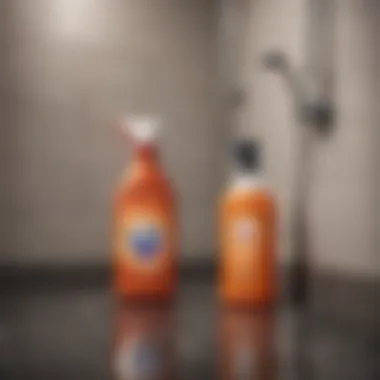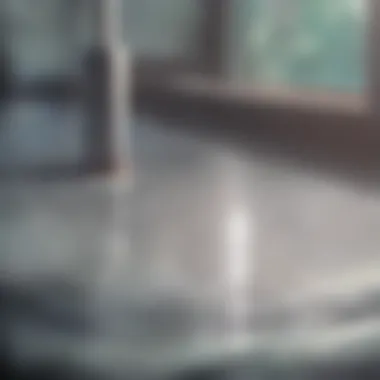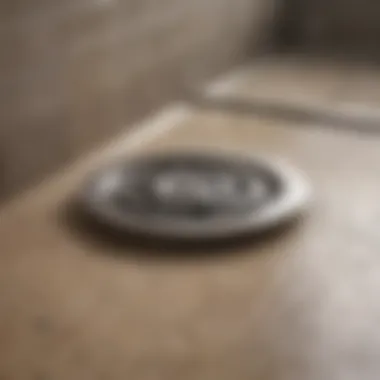Unclog Your Shower Drain: Effective Strategies Revealed


Intro
Clogged shower drains present not just a nuisance but also a challenge that can disrupt daily routines. From overflowing water to unpleasant odors, the issues are manifold. Understanding the dynamics of shower drain functionality is crucial to maintain a healthy household environment. This article aims to elucidate effective methods for unclogging shower drains, focusing on both prevention and remedy, ensuring that practical insights are accessible to all.
A comprehensive approach to this topic includes recognizing the buildup of hair, soap scum, and other debris that can cause blockages. By familiarizing oneself with preventive measures and troubleshooting techniques, homeowners can sustain a cleaner, more functional shower system. This guide targets individuals keen on understanding the intricacies of maintaining their plumbing systems, seeking to avoid the unnecessary costs of professional intervention while fostering a proactive maintenance culture.
Let's delve into practical strategies that promise to restore the flow to your shower drains efficiently.
Understanding Shower Drain Clogs
Clogs in shower drains create both frustration and inconvenience. Understanding the nature of these clogs is essential for tackling the problem effectively. When one comprehends the underlying mechanisms of drainage issues, they can apply targeted strategies to maintain flowing drains. This concept is not merely academic; it has direct implications for daily life and home maintenance. Clean drainage systems not only enhance comfort but also prevent a host of further complications, such as water damage and mold growth.
Common Causes of Clogs
Hair accumulation
Hair accumulation is a prominent cause of clogged shower drains. Hair, whether from daily washing or shedding, tends to gather in the drain over time. The interaction of moisture and soap can cause hair strands to tangle, creating a blockage. The fiber structure of hair makes it particularly efficient at capturing soap residue and other debris. This characteristic makes it a frequent contributor to drainage problems. Addressing hair accumulation early can prevent more severe clogs.
Soap scum buildup
Soap scum buildup results from the combination of soap residue, minerals in water, and body oils. Over time, this scum can create a hard layer within the drain pipes, significantly impeding water flow. The presence of soap scum is often underestimated, yet it remains a substantial factor in drainage issues. It is crucial to recognize this buildup since effective removal requires different approaches than those used for hair clogs. Understanding when and how soap scum accumulates can inform better cleaning routines and anti-clog practices.
Foreign objects
Foreign objects in a shower drain can lead to unexpected blockages. Items such as small toys, shampoo lids, or other miscellaneous objects can inadvertently fall into the drain. Their presence can create immediate clogs or contribute to slow drainage over time. Identifying foreign objects is usually straightforward, and their removal often resolves drainage issues rapidly. This cause is significant as it reminds homeowners to be mindful of what is around the drain area.
Signs of a Clogged Shower Drain
Slow drainage
Slow drainage is often the first noticeable sign of a clog. It occurs when the water does not flow as quickly as expected, pooling around the feet during a shower. Slow drainage usually indicates that debris is forming a blockage, obstructing normal flow. Observing this symptom early can guide timely intervention and prevent a complete obstruction from occurring.
Unpleasant odors
Unpleasant odors can be a clear indicator of a clogged drain. These odors typically arise from decomposing organic matter trapped within the drain. The presence of such smells should not be ignored, as they not only signify clogs but also potential hygiene issues. The unique feature of these odors is their ability to serve as an early warning sign. Recognizing this symptom can prompt timely action before the situation escalates.
Gurgling noises
Gurgling noises may seem harmless, but they often indicate an underlying problem with the drain. This sound occurs due to trapped air trying to escape from the blockage. Understanding that gurgling signifies an issue can lead to quicker response times. Addressing this early can save homeowners from a more complex repair process later. Identifying gurgling as a symptom highlights the importance of attentiveness to other signs in maintaining a functional drainage system.
Initial Assessment of the Clog
Assessing the clog is crucial before taking action. Understanding the blockage can save time, resources, and prevent potential damage. Knowing the severity of the clog can help determine which tools and methods to use. This assessment leads to more effective solutions and reduces the chance of repeating the process.
Identifying Severity
Light vs. Severe Clogs
Light clogs generally allow some water to drain, which means a simple approach may suffice. In contrast, severe clogs can stop drainage entirely. Recognizing the difference is critical. Light clogs may require minimal intervention like plunging or using a homemade solution. Severe clogs, however, often indicate deeper issues in the plumbing.
The main characteristic of light clogs is their quick drainage time. This means you can often fix it without much hassle. On the other hand, severe clogs can lead to water backups, creating an unsanitary condition. While light clogs are easier to manage, severe ones may need professional help, adding to potential costs.
Potential Damage Assessment
Evaluating potential damage is another key step. This involves looking for signs of leaks or water pooling around the shower area. If the clog leads to water backup, mold, and mildew growth can occur, posing health risks.


The main characteristic here is prevention. Early assessment can help avoid long-term structural damage to your home. Ignoring signs with the belief that a clog will resolve itself may bring unnecessary expenses later.
Gathering Necessary Tools
Plunger
The plunger is a well-known tool for unclogging drains. Its purpose is simple: create pressure to dislodge the blockage. This tool is essential because it can address both simple and moderate clogs effectively. The unique feature of using a plunger is its non-invasive nature. You do not need chemical solutions, making it an environmentally friendly option. It's beneficial, particularly for initial attempts, as it doesn't require special skills or training.
Drain Snake
The drain snake serves a different function. This tool is designed to reach deeper clogs that a plunger cannot. Its flexible design allows it to navigate bends in pipes, so it becomes vital for severe clogs. One advantage is its effectiveness in removing hair or stubborn debris. However, it may require more skill to use than a plunger, possibly leading to further complications if not handled correctly.
Buckets and Towels
Using buckets and towels is often overlooked yet essential. They are practical when dealing with messy situations that arise while trying to unclog a drain. A bucket collects any water that may overflow, while towels can help contain spills and dry off any issues. Their main characteristic is the protective role they play during the unclogging process, ensuring that your work area remains clean. However, they do not assist in solving the clog itself but are necessary for maintaining a tidy workspace.
Basic Unclogging Techniques
Understanding basic unclogging techniques is essential for effectively maintaining shower drains. In many cases, these methods can solve common clogging issues without the need for professional help. Knowing how to use tools like a plunger or a drain snake can be very beneficial. This knowledge provides confidence and equips a homeowner to tackle minor problems before they escalate into more significant issues.
Using a Plunger
Technique overview
The plunger is a common tool known for its simplicity and effectiveness. It functions by creating pressure within the drain system, which can dislodge blockages that clog the pipes. This technique is popular due to its accessibility; most households keep a plunger within easy reach. When properly employed, a plunger can remove a range of blockages, from hair to soap scum. An important characteristic of using a plunger is that it does not involve any harsh chemicals, making it safer for the environment and plumbing.
Effective use tips
To maximize the efficiency of a plunger, several tips are useful. Start by ensuring that there is enough water in the shower basin to cover the plunger's cup. This water creates better suction and helps in dislodging the clog more effectively. Additionally, maintaining a consistent motion while plunging can help work through different blockages.
Also, it is advisable to seal any overflow drain with a wet rag or another similar blockage. This helps channel the pressure directly to the clog. Highlighting these effective use tips is crucial because incorrect use can lead to inadequate results, leaving the blockage unresolved.
Employing a Drain Snake
Step-by-step guide
Using a drain snake provides a deeper method for dealing with stubborn clogs. This tool allows access to blockages that a plunger cannot reach. To begin the process, first remove the drain cover and insert the snake into the pipe. Several twists and turns may be necessary to maneuver around bends in the plumbing. The key advantage of a drain snake is its ability to grasp or break apart tougher clogs, such as those composed of solid hair knots or compacted soap scum.
After breaking through the obstruction, carefully withdraw the snake, ensuring no debris is left behind in the pipes. This step-by-step guide is invaluable, as improper use can potentially cause more damage to the plumbing system.
Precautions
Using a drain snake requires some caution. The tool can easily scratch or damage the inside of the pipes if not used gently. It is crucial to avoid applying excessive force, which can lead to more severe plumbing issues. Before starting, make sure to wear safety gloves to keep hands clean and protected. Highlighting these precautions is necessary as they can prevent potential plumbing disasters while ensuring a smoother unclogging process.
When dealing with clogs, knowledge of basic techniques can save both time and money in the long run.
Chemical Solutions for Clogs
Chemical solutions provide a quick and often effective way to handle clogged shower drains. They can break down stubborn blockages and restore proper drainage when other methods fail. However, it is important to consider not only the effectiveness of these chemical solutions but also their long-term impact on both plumbing systems and the environment. This section will discuss various chemical cleaners available, their characteristics, and what to be mindful of when using them.
Overview of Chemical Drain Cleaners
Types of Cleaners
There are two main types of chemical drain cleaners available on the market: enzyme-based and caustic cleaners.


- Enzyme-based cleaners utilize bacteria and enzymes to digest organic materials like hair and soap scum. They are effective for gradual clogs and are safer for pipes, making them a popular choice.
- Caustic cleaners, on the other hand, contain strong chemicals such as sodium hydroxide or sulfuric acid. They work by creating heat and breaking down clogs quickly, but they can damage pipes if used improperly.
The key characteristic of these cleaners is their mechanism of action, which determines their overall effectiveness. Enzyme-based cleaners are seen as beneficial because they are environmentally friendlier and less harmful to plumbing. In contrast, caustic cleaners offer immediate results but present significant risks including potential pipe damage and injuries if mishandled.
Environmental Considerations
When selecting a chemical drain cleaner, environmental impact becomes an important factor. Some cleaners, especially caustic types, can release harmful substances into the water system. This contributes to broader environmental concerns.
Many consumers are increasingly choosing products labeled as biodegradable or containing natural ingredients. This trend toward environmentally-conscious choices reflects a growing awareness of ecological responsibility.
However, the unique feature of environmentally-safe cleaners is that they often require more time to work compared to their harsher counterparts. This means that while they reduce the risk of environmental harm, users should be prepared for slower results. Additionally, they might not be practical for severe blockages that need immediate attention.
Homemade Solutions
For those looking for a more natural approach to unclogging drains, homemade solutions can prove effective. These alternatives often use common household items, avoiding harmful chemicals altogether.
Baking Soda and Vinegar Method
The baking soda and vinegar method relies on a simple chemical reaction. The mixture of these two ingredients can help break down clogs naturally. Baking soda, being alkaline, reacts with vinegar, creating carbon dioxide bubbles that can dislodge debris in the drain. This method is not only safe but also inexpensive and easy to use.
This method’s key characteristic is its ability to target organic matter without introducing toxic substances into the environment. Its advantages include safety and the fact that both ingredients are commonly found in most households. However, this method may require multiple applications for tough clogs.
Salt and Hot Water Approach
The salt and hot water method utilizes the abrasive nature of salt combined with the heat from boiling water to flush out clogs. Salt can help dislodge buildup, while hot water helps to dissolve greasy substances. This method is straightforward and effective for many minor drainage issues.
The distinguishing feature of this method is its simplicity and accessibility. It offers a quick solution without the need for specific tools or chemicals. Nevertheless, it's crucial to note that while this method is generally effective, it may not work for severe blockages. Persistent clogs might warrant stronger interventions.
Regular maintenance and preventive measures can greatly reduce the reliance on chemical solutions and minimize clogging issues in the future.
Preventative Measures for Drain Maintenance
Preventative measures are essential in maintaining the efficiency and longevity of shower drains. By addressing potential issues before they escalate into clogs, homeowners can save time, frustration, and money. Implementing regular maintenance practices proves effective in ensuring that water flows freely.
Regular Cleaning Routines
Frequency recommendations
Having a routine for cleaning the shower drain is an effective strategy to avoid serious clogs. Homeowners should aim to clean their shower drains at least once a month. This regularity is beneficial because it removes hair, soap scum, and other debris that tends to build up over time. Monthly cleaning can help to maintain a visibly clean and operable shower.
This frequency is favorable because it tackles minor issues before they worsen. Additionally, homeowners might choose to clean more frequently if they notice heavy use of the shower or if they have long hair. However, overly frequent cleaning without necessity may lead to wear on the drain parts.
Cleaning tools
Utilizing appropriate cleaning tools is important for effective drain maintenance. Essential tools include a plunger, a drain snake, and disposable gloves. A plunger can help dislodge minor clogs, while a drain snake is perfect for reaching and removing hair or build-up deep in the pipes. Disposable gloves protect hands from potentially harmful substances during cleaning.
The selection of these tools is practical and efficient, as they do not require significant investment and are readily available. One downside is that while these tools are effective, improper use can lead to damage or might not resolve deeper issues within the plumbing system.
Using Drain Covers
Types of drain covers
Using a drain cover is a proactive approach to preventing clogs. There are various types of drain covers available, including mesh, silicone, and pop-up styles. Mesh covers are excellent for catching hair, while silicone covers can fit snugly over drains, providing effective filtering.
These covers are popular as they prevent debris from entering the drain in the first place. However, they require regular cleaning themselves to ensure they function correctly. If not cleaned, they may also lead to blockages.


Benefits of using covers
The benefits of using drain covers are numerous. They significantly reduce the volume of debris entering the drain, which directly lowers the chance of clogs. Additionally, they are often easy to install and maintain, which makes them appealing options for homeowners looking for simple solutions.
Using cover is a cost-effective strategy, as investing in a good quality drain cover can save substantial future repair costs associated with serious clogs. However, homeowners should be mindful that covers should be consistently checked to ensure they are clear of buildup.
When to Seek Professional Help
Determining when to call professionals for a clogged shower drain is crucial. Many homeowners try to resolve clogs on their own, but sometimes the situation escalates. Knowing when to seek professional help can save time and prevent further issues. Professionals have the tools and expertise to tackle stubborn clogs that ordinary methods cannot handle.
Professional Drain Cleaning Services
Indicators for Professional Assistance
There are key indications that suggest you should seek professional assistance for your clogged shower drain. If the clog persists after multiple home remedies, this is one sign that your skills are limited. Another indication is the presence of water backing up in other fixtures. This can mean the issue is not isolated to just the shower drain. Additionally, persistent odors can point to a deeper blockage that needs specialized tools and techniques.
A critical feature of recognizing these signs is understanding the urgency of the situation. Neglecting these indicators can lead to more significant plumbing issues and higher repair costs. Seeking professional help can prevent larger mishaps down the line, which is a key aspect of maintaining home plumbing efficiently.
Service Options
Once you decide to contact professionals, a range of service options will usually be available. Local plumbing companies often offer drain cleaning services, where they use specialized equipment like high-pressure water jets or video inspection technology to locate and remove clogs.
The ability to utilize advanced technology is an advantage of these services. Professionals can assess the problem accurately and execute appropriate methods for unclogging the drain. This can save homeowners from unnecessary expenses caused by trial-and-error methods. However, utilizing professional services can sometimes be pricier compared to DIY methods, making it essential to weigh the cost against the potential benefits.
Avoiding Costly Damage
Long-term Consequences of Neglect
Ignoring drain issues can lead to long-term damage, such as pipe corrosion or leaks. These issues often don’t manifest immediately but can cause severe problems later on. For instance, stagnant water from inadequate drainage can lead to mold growth, which presents health risks and further repair costs.
The distinctive aspect of understanding long-term consequences is recognizing that early intervention often leads to lower repair costs. A small clog left untreated can escalate into a significant plumbing failure, which could lead to extensive repairs or even complete system replacement. Hence, addressing the small signs promptly is a beneficial strategy for homeowners.
Budgeting for Repairs
Proper budgeting for drain repairs should factor in both immediate and future needs. Creating a budget can prevent unexpected financial strain when plumbing issues arise. This includes allocating funds not just for current repairs, but also for potential future clogs. Understanding your home’s plumbing system and how often it needs maintenance is crucial in developing a realistic budget.
A unique aspect of budgeting for repairs is keeping in mind that different environments affect the plumbing condition. Homes in regions with older infrastructure may need more frequent professional help. Therefore, adapting your budget to reflect these needs is essential for ensuring your home’s plumbing remains in good condition without causing financial burden.
The End and Best Practices
When addressing the issue of clogged shower drains, the conclusion and best practices section serves as a vital summary. It encapsulates the essential strategies available to homeowners, making it easier to manage this common household concern. The practices outlined here are not just reactive measures; they also encourage a proactive approach to drain maintenance. This is critical, as preventing clogs can save time, effort, and money in the long run.
Summary of Effective Techniques
Recap of methods
The methods discussed throughout the article highlight key techniques for unclogging shower drains. Using basic tools like a plunger or drain snake has proven effective in many cases. These methods are straightforward, making them a popular choice among homeowners. The simplicity of these techniques means that they can be done without extensive plumbing knowledge, thus empowering individuals to tackle clogs themselves. However, they can have limitations depending on the severity of the blockage.
Importance of maintenance
Maintaining clean and functional shower drains is crucial. Regular maintenance reduces the likelihood of clogs forming and can extend the life of your plumbing system. One key characteristic of maintenance is its proactive nature. This approach emphasizes the need to routinely check and clean drains, effectively preventing minor issues from escalating. Although it requires consistent effort, the unique feature of maintenance is that it often requires minimal resources, making it accessible for various households.
Final Thoughts on Home Drain Care
Emphasis on prevention
Prevention is a primary strategy in managing shower drain issues. Emphasizing prevention means taking steps to avoid the initial issue rather than solely focusing on resolution. Regular cleaning, using drain covers, and being mindful of what goes down the drain are all effective prevention methods. Their major advantage lies in their ability to minimize the occurrence of future blockages, thus preserving the functionality of the shower system.
Encouragement for regular checks
Encouraging regular checks of your shower drains reinforces the necessity of ongoing maintenance. This simple habit can help identify early signs of blockages before they become problematic. The key feature here is the proactive assessment of your plumbing system. It is beneficial because it fosters a routine of awareness about the condition of drains, which often leads to more informed decisions when issues arise. However, one disadvantage might be the challenge in remembering to perform these checks. Scheduling them can significantly mitigate this issue, ensuring that drain care is taken seriously.
Effective drain maintenance strategies form a continous cycle of care, effectively enhancing home plumbing longevity.















